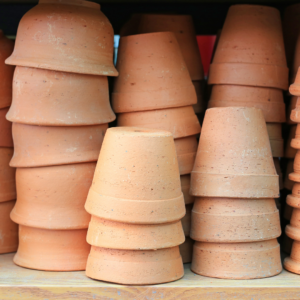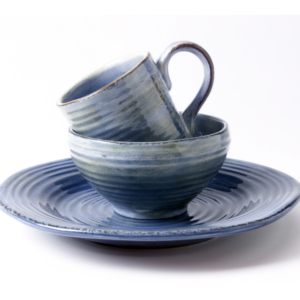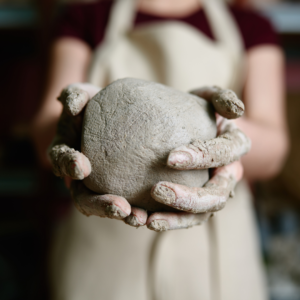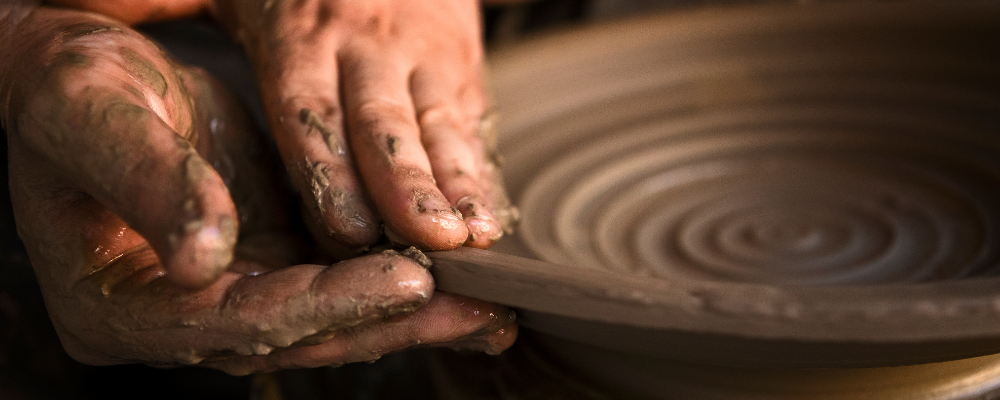Pottery needs creativity and technique. That’s what you’ll learn in pottery-making classes and YouTube how-to videos.
But what these instructions don’t tell you is that knowing the clay in your hands makes a big difference in your artwork.
When you understand pottery clay, it gives you an edge in taking advantage of its unique properties and working with it a lot better. And that’s our goal for this article.
To start, here’s a sneak peek of what you’ll need to know about pottery clay.
- Pottery Clay Lingo
- Most Used Pottery Clay Types
- How to Buy Pottery Clay
Pottery Clay Lingo (terms you should know about pottery clay)
Potters and pottery supply shops use certain lingos to describe and pinpoint the type of clay needed for the artwork.
Clay Body
A clay body is a mixture of clay or different types of clay.
Some of them need to be mixed with sand, minerals, grog, organic matter, and other minerals to achieve the right consistency for use in pottery.
Mixing clay bodies takes time and skill.
Moist and Dry Pottery Clay
Moist pottery clay is your ready-made clay. It has already been mixed into the right consistency with the right amount of additives and minerals. But they are not as cost-efficient as dry clay.
Dry pottery clay, on the other hand, is compact and can save you money from shipping cost, storage, and weight. They can be mixed to your liking, giving your clay that personal touch. But learning how to mix pottery clay takes time and a lot of patience.
For beginners, it is best to buy moist pottery clay at first. When you’re ready, you can take advantage of the dry clay later.
Plasticity
The plasticity of pottery clay depends on how workable or easily formed and moldable they are. The more plastic the clay is, the easier it is to mold or form.
Firing/Firing Temperature
Firing is when you expose the clay to high heat temperatures in a kiln. And the clay’s firing temperature is the range of heat it needs to be exposed to in order to dry and attain maximum hardness.
Clays are classed depending on their firing temperatures. A pottery clay can be low, mid, or high fire.
- Low fire – 1087 F to 2088 F
- Mid fire – 2106 F to 2262 F
- High fire – 2280 F to 2345 F
Most Used Kinds of Pottery Clay
Pottery clay in essence is a mix of different types of clay, minerals, organic material, and other additives. So, they are identified according to the main type used in the mix.
Earthenware Clays

Plasticity: High
Firing temperature: 1745 F to 2012 F
Wet colors: Red, yellow, orange, and light gray
Fired colors: brown, orange, red, medium gray, white, and buff
Earthenware clays are the most common types of clays and the earliest going back to ancient Greek. Because of their high plasticity, earthenware clays tend to be sticky. Most earthenware clays are iron-rich which gives their brownish, “pot” color.
Stoneware Clays

Plasticity: Medium
Firing temperature: 2150 F to 2336 F
Wet colors: gray
Fired colors: light gray to medium gray
Stoneware clays are dense and when fired to maturity – reaching optimum hardness, are non-porous and resistant to liquid. They are perfect for vases and other ceramics and pottery that are made for storing liquids.
The firing temperature a stoneware clay is exposed to affects its color, turning it from light to medium gray. Mid-fire stoneware clay is heated from 2150 F to 2260 F while high fire stoneware is between 2200 F and 2336 F.
Ball Clays

Plasticity: High
Firing temperature: 2336 F
Wet colors: dark gray
Fired colors: light gray, light buff
Ball clays have few impurities and minerals. That’s why they come off like ivory when matured. But ball clays shrink too much that they cannot be used on their own. Other clays have to be added to manage their shrinkage.
Fire Clays

Plasticity: High
Firing temperature: 2696 F
Wet colors: gray with spots
Fired colors: buff and buy with speckles
Fire clays are relatively free from mineral impurities but they have spots of iron that give the pottery speckles when fired. Often, fire clays are mixed with stoneware clay bodies to give it an extra roughness and increase its firing temperature. They are also made as cone packs to support wares or shelving in kilns.
Porcelain (Kaolin clays)

Plasticity: Low
Firing temperature: 3272 F
Wet colors: light gray
Fired colors: very light gray, near-white to white
Kaolin clays are literally free of minerals. It’s the reason they have very light colors when wet and after firing. They are also hard to work with as a result of their low plasticity. That means you need more physical strength to form or mold them.
To manage their workability, they are often mixed with other clays and also lower their firing temperatures.
How to Buy Pottery Clay
Though there are still physical pottery supply stores, most of us turn to Amazon or other online shops. While physical stores may have sales personnel that you can talk to and ask for advice, online shops don’t. So, you better know what you’re buying or it’ll be a waste of time and money.
You’ll find pottery clay sold in/by:
- Weight in increments of 5 lbs.
- Dry or Moist
- Low, Mid, or High Fire
- Type of clay
For example, you’ll find online a moist 10 lb low fire earthenware clay. Another thing to note when purchasing pottery clay is that it may be only suitable for hand-building, throwing, or modeling. So, you have to make sure that your pottery clay is consistent with the pottery method you use.
There you go.
Now you know more about your material than you did before.
Take into heart the types of clay and their properties, especially their maturity color, textures, and firing temperatures.
And don’t forget how potters classify and describe them so you won’t purchase the wrong kind of clay.
Lastly, have fun with your art. If you need more tips regarding all things pottery, feel free to scour the pages of Pottery Whim.

